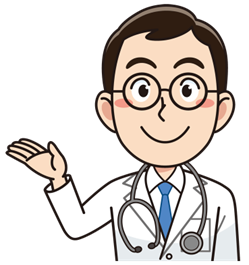ILC's treatment for
a Strained Back
Having been adopted in over 54 countries globally,
the "Cellgel Method" for treating lower back pain
is now available in Japan
For those who have been told it was impossible to operate,
For those who have had recurrence of pain post-surgery,
A low-risk, outpatient treatment is now an option for you.
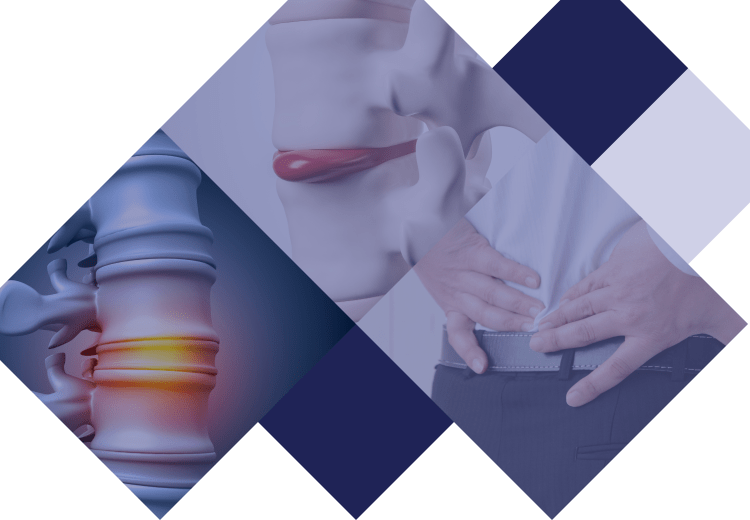
What is a strained back?
A strained back is a terrible condition that suddenly causes severe pain in the lower back and makes it almost impossible to move. As a side note, a strained back, similar to "headaches" and "sciatica," are not names of diseases, but names that describe symptoms.
It is often caused by the following actions or behaviors. If any of the following sounds familiar to you, you may have experienced a strained back.
- Suddenly lifting something heavy
- Forcing yourself to bend over to pick up something out of reach
- When you twist your upper body while holding a heavy object
- When you make a twisting motion with your upper body
- When you try to get up in the morning
- When you suddenly feel a sharp pain in your lower back while playing sports
- When you bend your back vigorously
- After sneezing
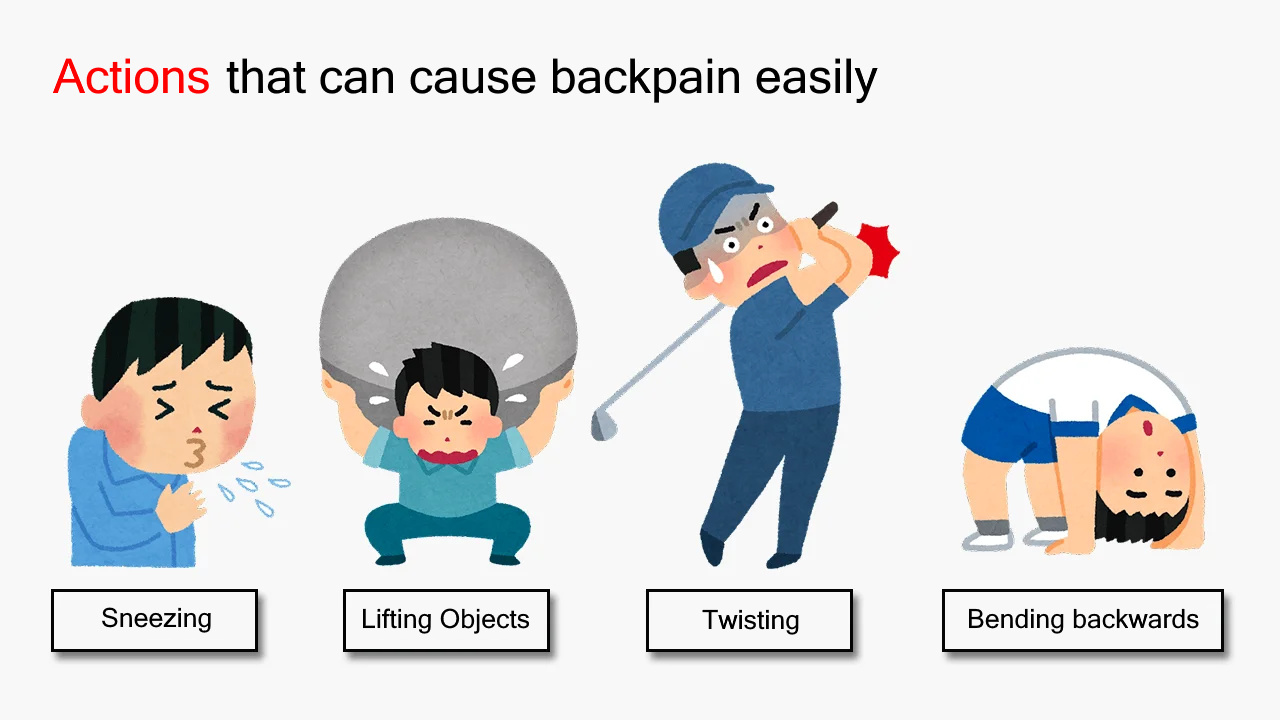
There's more than that, but,
For those who repeatedly have strained backs, even if you don't do any of these actions, you can still strain your back.
Because a strained back is extremely prone to recurrence, it is necessary to pay attention to daily your lifestyle and diet as well.
What causes a strained back?
We believe that there are three main causes of strained backs, and in fact, many of our patients have had repeated strained backs due to the first cause.
At our clinic, we believe that there are three main causes of strained back, and there are many cases in which the patients who visit our clinic have repeatedly strained back due to the first cause.
-
Strained back caused by an intervertebral disc
The intervertebral disc consists of a jelly-like substance called the nucleus pulposus, surrounded by a hard ring-like layer called the annulus fibrosus. In a healthy disc, the surrounding layer, the annulus fibrosis, has no scars or holes.

However, when a heavy object is lifted or a sudden twist is applied to the intervertebral disc, the annulus fibrosus may be damaged or a hole may be formed. When the jelly-like nucleus pulposus leaks out of the wound or hole, it causes inflammation and causes severe pain.
Even if you leave the inflammation alone, it will naturally subside. However, there is a very important point here: "A damaged annulus fibrosus does not heal naturally."
For those who repeatedly have strained backs, from the second time onward, a strained back can happen even without a strong impact.
In other words, the nucleus pulposus easily leaks from the damaged annulus fibrosus, which easily causes inflammation and makes you feel like you are going to have a strained back, or actually strain your back. -
Strained back caused by facet joints
The spine, like the elbows, knees, and hips, has joints called facet joints. Inflammation can cause severe pain, and this is called facet joint disorder.
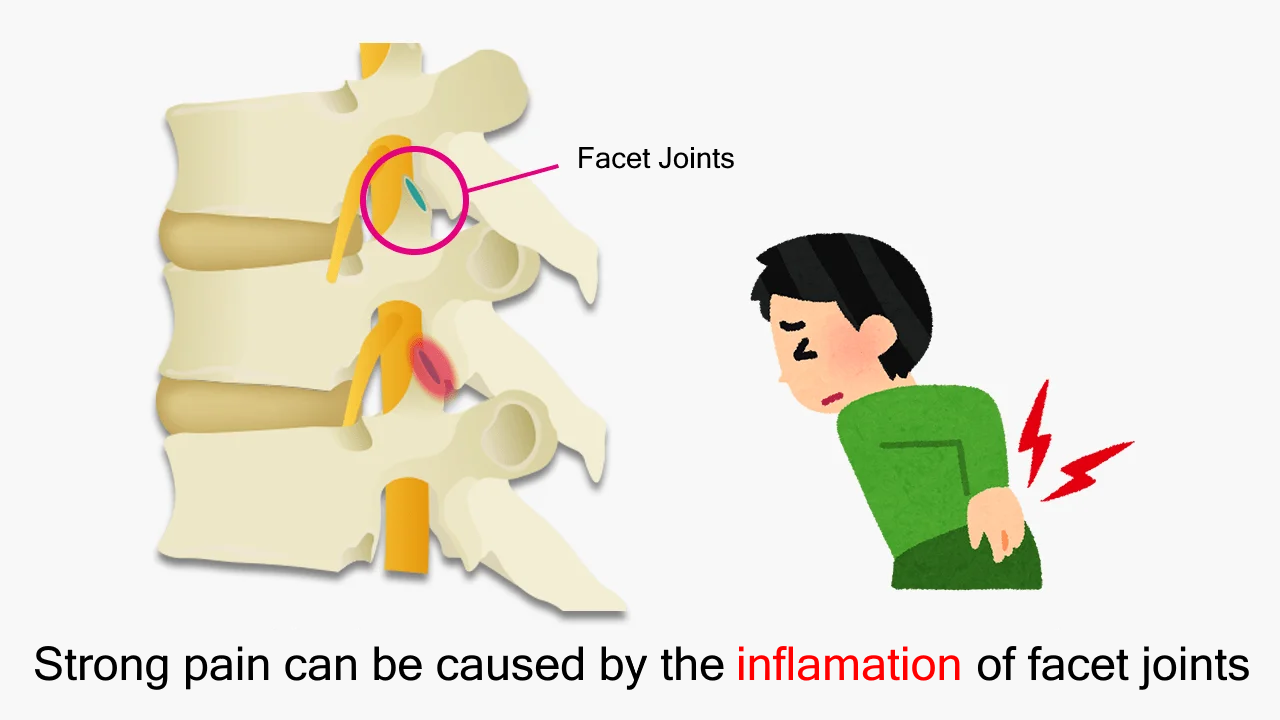
Facet joints have more nerves that feel pain than other places in the body, so even a little inflammation can cause severe pain, which is one of the causes of back strain.
Inflammation of the facet joints will subside over time as long as you rest, there are many cases in which painkillers and other oral medications are taken to see how the inflammation subsides. -
Strained back caused by fascia/muscles
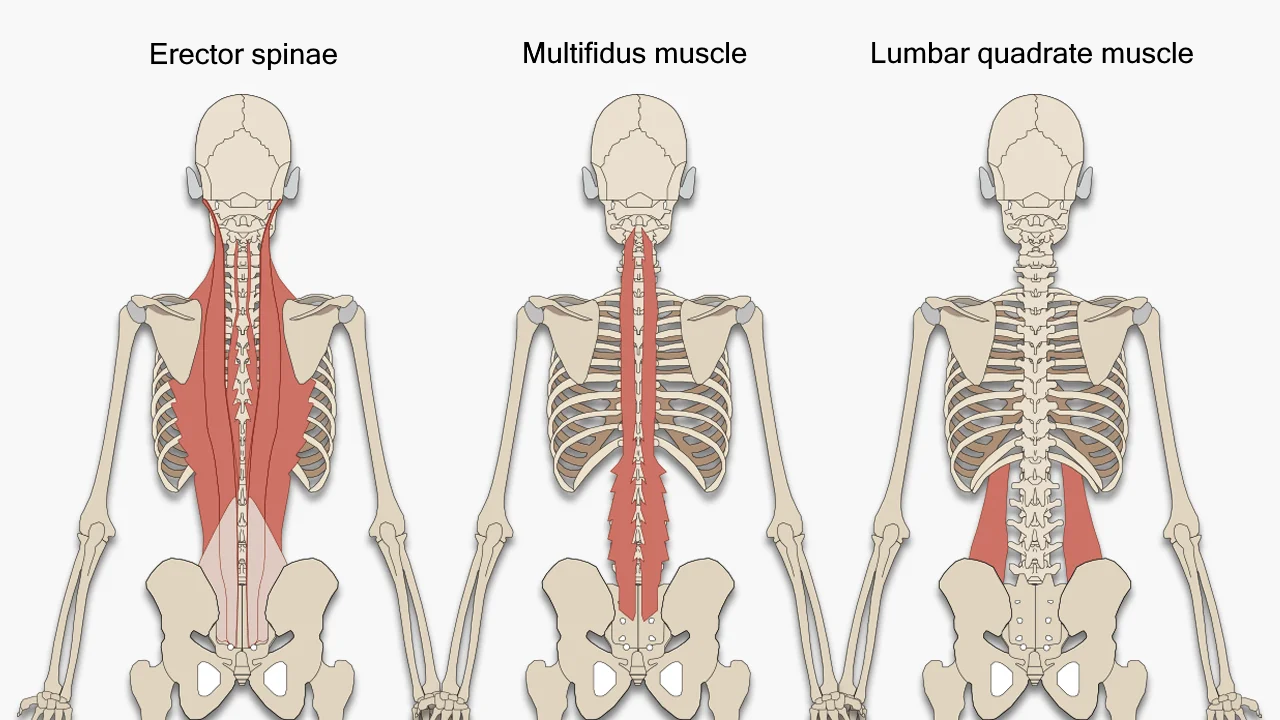
This is a condition in which the muscles that move and support the lower back, such as the erector spinae, multifidus and quadratus lumborum muscles, are separated or the membrane covering the muscles is damaged, causing instant and sudden pain.
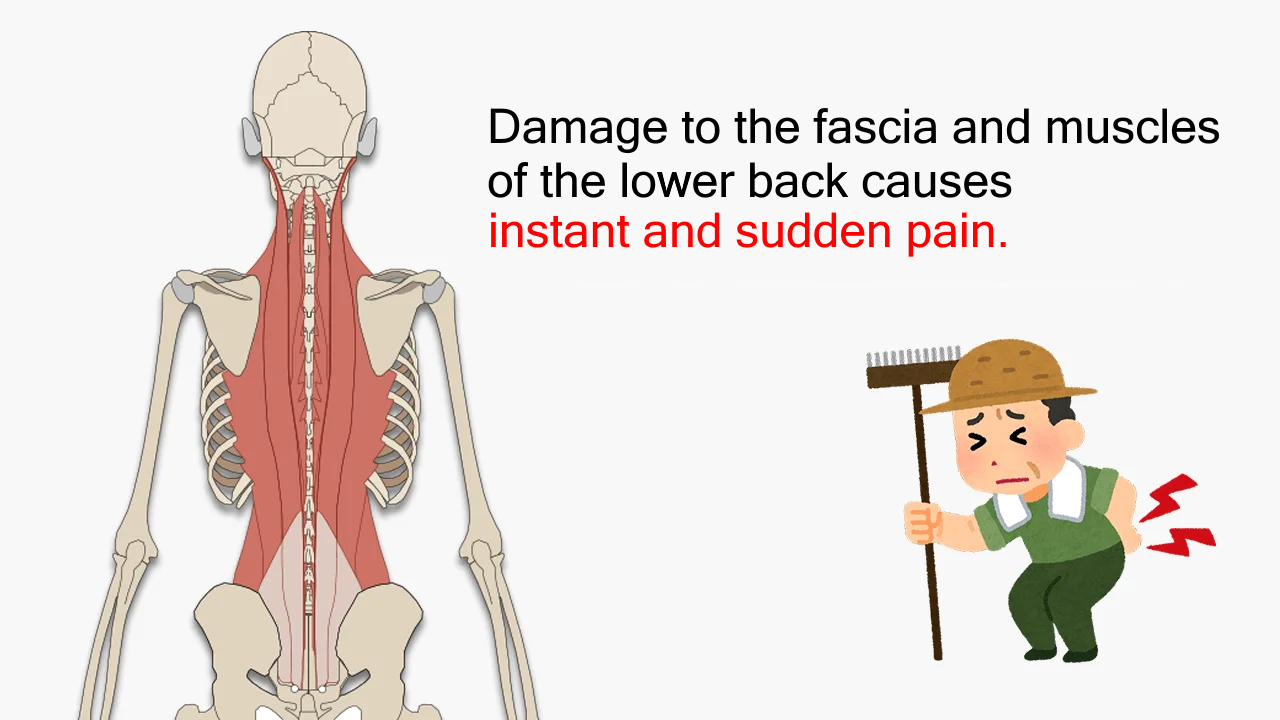
However, if you take pain relievers for fascia or a strained back due to fascia and continue your daily life within a pain-free range, the pain will subside in a few days to two weeks, and the symptoms will be cured in relatively many cases so you don't need to worry.
What happens when you repeatedly strain your back
If you repeatedly strain your back from the intervertebral disc, the nucleus pulposus, which is the cushioning component of the intervertebral disc, will leak out little by little, and the intervertebral disc will gradually collapse. A damaged intervertebral disc can lead to various diseases.
If the intervertebral disc collapses and bulges out, it can cause a herniated disc or spinal stenosis. In addition, if the intervertebral discs are crushed and become unstable, the upper and lower spine will easily shift, and if it shifts in earnest, it will become a state of spondylolisthesis.
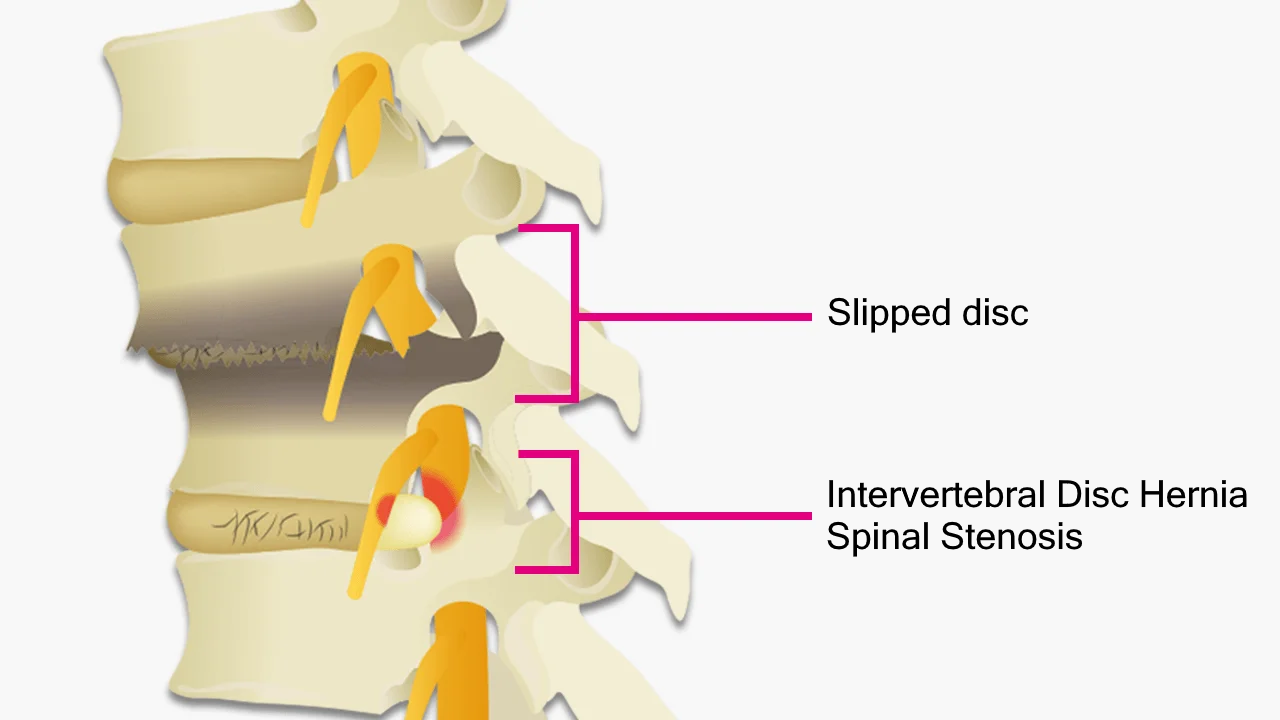
If the symptoms progress to these diseases, symptoms of "numbness" as well as pain often appear from the buttocks to the legs. When this happens, treatment options are limited and treatment effectiveness is difficult to achieve, so it is very important to first have an MRI at an orthopedic clinic as soon as possible to confirm the condition.
Treatment for a strained back
As mentioned above, strained back caused by intervertebral discs will recur repeatedly, so it is necessary to repair the damaged intervertebral discs in order to solve the root issue.
Among the four treatment methods in our clinic, only the Cellgel method has the ability to repair intervertebral discs.
Since many of our patients come from far away,
we are happy to give free consultations to see which treatment is best for you
We'll diagnose your MRI images for free!
Treatment at ILC
There are four main treatments at our clinic.
As mentioned above, the root cause of each back pain disease is "inflammation and deformation due to aging of the intervertebral discs." Although the four treatment methods have different features and advantages, we would like to first introduce the "Cellgel method," which is the only one capable of intervertebral disc repair.
The Cellgel Method
About Cellgel
The Cellgel method is an advanced treatment for low back pain that has been implemented in more than 54 countries worldwide, predominantly in Europe.
As with other treatments, it does not decrease the disc volume, and since the drug remains in the disc as a gel-like implant after treatment, the disc can be preserved. Recent studies have also shown that the volume of the disc increases after treatment.*1
It is also thought that by repairing the disc and preventing leakage of the Nucleus Pulposus, the disc itself will restore its normal function with its own regenerative ability (*2).
*1 Source: European Journal of Radiology 109 (2018) 101–107 , Efficiency of an ethyl alcohol gel in symptomatic disc hernation
*2 Source: International Journal of Spine Surgery Vol. 15 Appendix 1 from regenerative treatment of disc degeneration
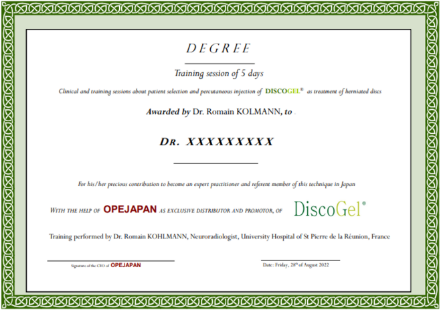
"Very good or good results were obtained in 202 (91.4%) of the 221 patients in group A. Of the 44 patients in group B, 37 patients (84%) presented very good or good results and in 9 (82%) of the 11 patients of group C, we obtained similar results. There was no allergic complication in any of our patients. Long-term follow-up magnetic resonance showed a dramatic reduction in hernia volume."
- Dr. J. Theron, one of the world's leading experts in the treatment of Celgel method, from his research article "Percutaneous Treatment of Lumbar Intervertebral Disk Hernias With Radiopaque Gelified Ethanol - A preliminary study."
Merits of Cellgel
- Possibility to repair intervertebral discs where unable to using surgical or laser treatment
- As the disc is repaired, the disc itself regains its original normal function through its own regenerative ability
- The Cellgel method uses local anesthesia over general anesthesia used in conventional surgery, making it less burdensome on the body
- Treatment is done with a thin needle, so the wound is minimal and recovery is rapid
- Treatment is very short, allowing for outpatient day treatment
- Safe, modern treatment proven in more than 54 countries around the world
Flow Cellgel Treatment Process
-
01 Examination
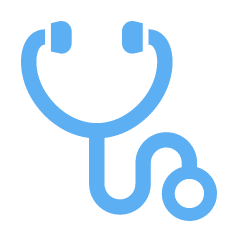
MRI and X-rays will be taken, followed by a doctor's diagnosis.
If the diagnosis proves the Cellgel method suitable, treatment can begin that same afternoon. -
02 Before
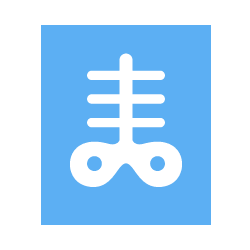
TreatmentAfter entering the treatment room and administering local anesthesia to the lower back, a needle is inserted into the intervertebral disc identified in the examination.
A contrast scan is performed to confirm the location of the damaged disc. -
03 Treatment
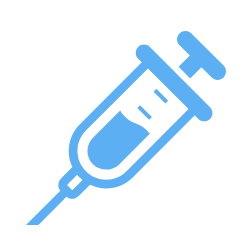
The Cellgel drug is administered to the damaged area while confirming the location of the disc with a fluoroscopy device.
Once the drug has been absorbed, the needle is removed and the bleeding is stopped.
-
04 Returning
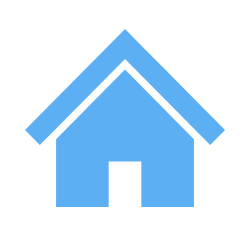
HomeAfter the treatment, the patient recuperates in a private room for about an hour, and then allowed to go home after the post-treatment examination.
*Resting time depends on the patient's symptoms and condition.
Price Cost of Treatment for the Cellgel Method
| Number of Discs Treated |
1 disc | 2 discs | 3 discs | 4 discs | 5 discs |
|---|---|---|---|---|---|
| Treatment Cost | 1,320,000 JPY | 1,430,000 JPY | 1,540,000 JPY | 1,650,000 JPY | 1,760,000 JPY |
Swipe left/righ
* The cost of treatment is indicated including taxes.
*If treatment is performed at our clinic, all examination/diagnosis costs and test costs such as MRI are included in the above costs.
*This treatment method is not covered by Japanese health insurance, so you will have to pay for the entire treatment yourself.
*Payment by credit card (VISA, MasterCard, JCB, American Express, Diners, Discover) is also possible.
*If you would like rehabilitation (low back pain specialized rehabilitation), it is also possible to pay by bank transfer.
*If you live and work in Japan, you can receive a tax refund by filing your final medical expense return.
FAQ Questions about strained back and treatment
-
QWhat long does it take for a strained back to get better?
-
ASevere pain will be relieved in about a week, and in many cases it will be relieved to the extent that there is no problem in about a month.
If severe pain persists for more than a week, it is recommended that you see an orthopedic surgeon as there may be a problem such as a fracture.
-
QWill a strained back heal naturally?
-
AThe symptoms are caused by tissue damage due to sudden external force. If the damaged area can heal itself, it will heal naturally.
-
QHow can we heal a strained back faster?
-
AYou should try to carry out your daily life as much as possible while taking medicine such as painkillers. Also, try to warm the painful area as much as possible.
-
QWhat should I do if I have a strained back?
-
ATry to sleep on your side with your knees bent or take a comfortable position without forcing yourself to move.
You should only ice your back on the day that you strained your back.
In addition, when the pain is strong your breathing becomes shallow, and the sympathetic nerve becomes dominant and falls into a state of hypersensitivity to pain. By breathing slowly through the nose as much as possible, the parasympathetic nerves start to work and the hypersensitivity to pain can be suppressed.
-
QIs there something that I shouldn't do when I have a strained back?
-
AYou shouldn't try to move in a difficult way or stretch the affected area. It's also not good to stay still for too long as well.
-
QWhat are the first symptoms of a strained back?
-
ASudden pain in the lower back, buttocks, pain radiating to the lower extremities, numbness, etc.
-
QWhat is the difference between a strained back and a herniated disc?
-
AA strained back is sudden pain caused by joints/muscles/fascia/ligaments/intervertebral discs.
Disc herniation, on the other hand, refers to the leakage of the nucleus pulposus from the intervertebral disc.
-
QHow do I know if my symptoms are of a strained back?
-
AThere is no clear standard, but it is a sudden onset of pain that makes it impossible to move.
-
QCan I take a bath with a strained back?
-
AIf the pain is not sudden, it's okay to take a bath.
Warming up the body improves the flow of blood and temporarily makes the symptoms stronger, but it is not a big problem.
-
QWhat are the things to watch out for in order to not strain your back?
-
ADo not stay in the same posture for too long, and move the thoracic spine, lumbar spine, hip joints, ankles and toes appropriately.
-
QWhat is another name for strained back?
-
AAcute low back pain.
ILC Rehabilitation X Strained Back Treatment
Although the Cellgel method can repair and regenerate the disc itself, and other treatment methods we offer can fundamentally heal the disc; it is possible that the cause of back pain is not only the disc, but also muscles, joints, and ligaments that are affected by the disc.
In cooperation with our rehabilitation specialists, we recommend treating back pain caused by muscles, joints, and ligaments together.
We also offer a short-term intensive program for patients who live far away or overseas.
-
ILC's Low Back Pain Treatment
Outpatient Treatment
Improve back pain disorders/
symptoms in relation to the nerves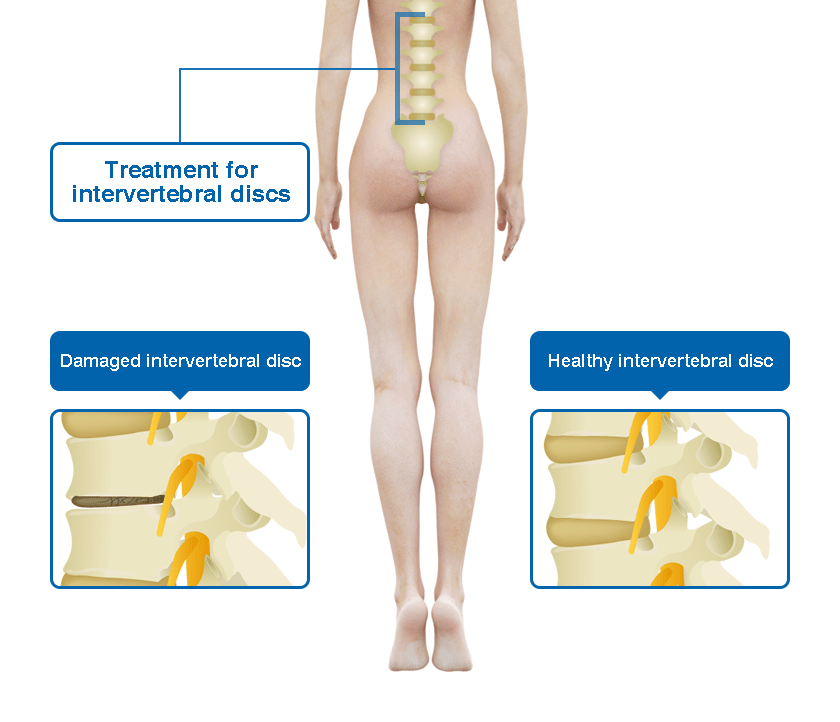
-
ILC's Rehabilitation Program
Specialized Low Back Pain Rehabilitation
Improve back pain disorders/symptoms in
relation to the joints, muscles, ligaments
-
01
ILC's Specialized Back Pain Rehabilitation
Our Rehabilitation Approach to Strained Back
When you move your body in a state where your body is stiff or you are not good at using your body, stress concentrates on the joints/muscles/fascia/intervertebral discs/ligaments around the lumbar spine, causing damage to local tissues a strained back is said to occur. It is said that about 60% of people who have experienced a strained back once will experience it again, and it is one of the factors that lowers a person's quality of life. The reason why a strained back is likely to reoccur is that there are tissues such as the intervertebral discs that are prone to damage, and that the way you use your body in your work and daily life makes it easier for the tissues around the lumbar spine to be burdened. In the former case, it is most important to repair the intervertebral disc, and in the latter case, it is essential to create a body in which a strained back cannot happen.
-
02
ILC's Specialized Back Pain Rehabilitation
How to Evaluate Strained Back
First of all, we will check in detail what factors are causing the strained back, such as the cause of the pain, your daily habits, your field of work, etc. From this evaluation, the stress that is expected to be a burden on the body is specifically identified in which part of the body and when the body is moved. While moving the , we will evaluate not only the waist circumference but also the whole body from the tip of the foot to the top of the head.
-
03
ILC's Specialized Back Pain Rehabilitation
Detailed Description of the Rehabilitation for a Strained Back.
At our rehabilitation center, we believe that it is important not only to alleviate the pain that is currently occurring, but also to investigate which movement of the body puts a burden on the lower back, correct the movement, and build a body that can prevent a reoccurence. Therefore, not only do we do rehabilitation on the bed but also observe the patient's own movements, to help them understand which are bad and which are good in normal movements, standing, sitting, walking, and actually moving the body. We are doing rehabilitation so that we can use the body properly while moving.
We do not perform rehabilitation that requires large movements or strong strength, and instead focus on how to move the body well. -
04
ILC's Specialized Back Pain Rehabilitation
Treatment Period for Strained Back Rehabilitation
The low back pain guidelines do not strongly recommend rehabilitation immediately after the onset of a strained back, instead, lifestyle modifications and acupuncture are the mainstays of treatment. If you still have pain for more than a month after the onset of a strained back, you will need rehabilitation. In that case, the rehabilitation period varies depending on the severity of the symptoms, the injured area, the work content, and the understanding of exercise. Treatment should be continued for 1-2 months.
If the damaged part originates from the intervertebral disc, the intervertebral disc needs to be repaired, so more days than the number of days above are required.
We aim to achieve 100% effectiveness of treatment while incorporating the latest technology, so we spend at least 30 minutes with each patient to carefully and meticulously examine the patient's concerns in order to make a proper diagnosis and propose the most suitable treatment methods.
We are certain to find a way to alleviate or eliminate the pain and numbness you are experiencing, so please do not give up and give us a call instead!
- Tadaaki Minowa, Clinic Director
